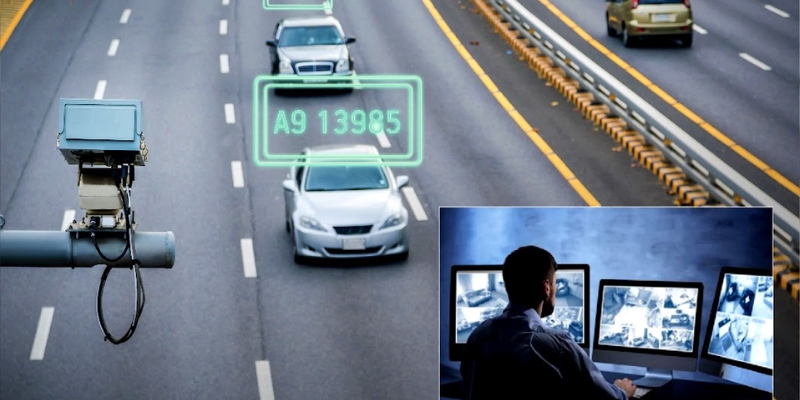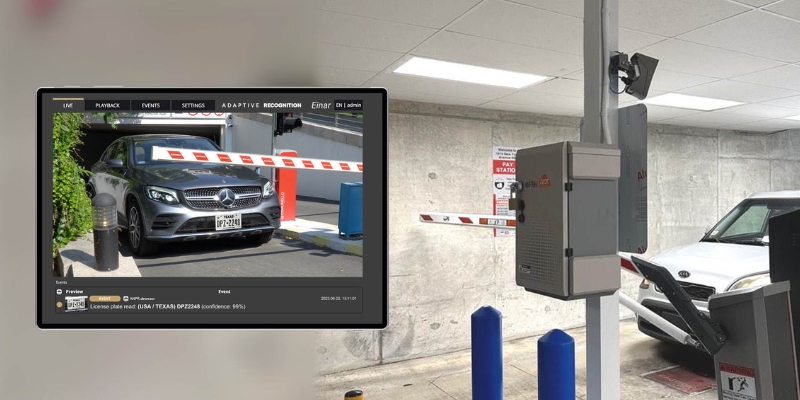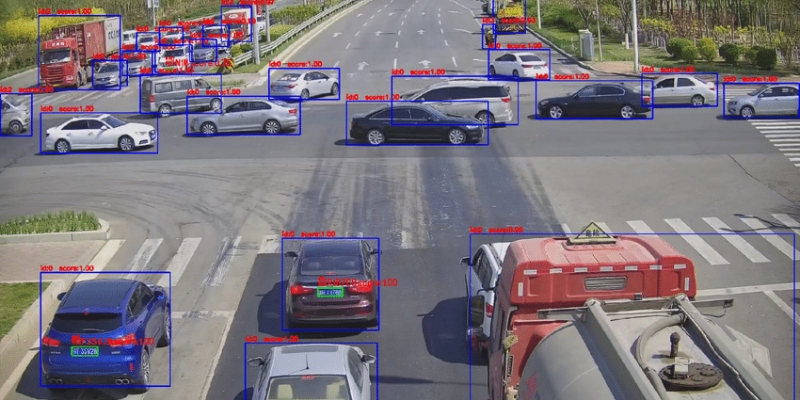Lucia Lee
Last update: 11/08/2025
While License Plate Recognition (LPR) has been around for a while as a cornerstone of traffic management, traditional systems are falling short due to their reliance on rigid, rule-based algorithms. That’s why forward-thinking businesses are embracing computer vision for license plate recognition - a cutting-edge technology that makes LPR systems smarter and more effective than ever before. Keep reading to explore how it works, why it matters, and what it means for businesses like yours.
Computer vision is a branch of artificial intelligence (AI) that enables machines to interpret and understand visual inputs - such as images and videos - much like the human eye, but with greater speed and consistency. By combining cameras, sensors, and advanced algorithms like deep learning, computer vision allows systems to not only "see" but also make decisions based on what they detect.
One of its key applications is Optical Character Recognition (OCR) - a technology used to identify and extract text from images. OCR plays a central role in License Plate Recognition (LPR), also known as Automatic Number Plate Recognition (ANPR). It captures license plate data from video or images and converts it into digital information in real time, enabling fast and accurate vehicle identification.
Crucially, it’s computer vision that powers the intelligence behind LPR. It detects vehicles, isolates license plates, and ensures precise character recognition - even in challenging conditions like poor lighting, high speeds, or angled views. As a result, what once required manual effort or expensive hardware is now fully automated and scalable, thanks to the power of computer vision and OCR working together.
Computer vision allows LPR systems to identify and interpret license plates with an unprecedented level of accuracy, but how does it do its magic? Here's a breakdown of the process:
Image acquisition and pre-processing
The first step is capturing visual data through cameras - typically IP or CCTV models - installed at strategic points like gates, parking lots, or roadways. Camera calibration ensures that the captured images are aligned correctly and of sufficient quality. This stage often uses infrared lighting for effective performance in low-light conditions.
Also read: How to Install Smart CCTV: DIY Smart CCTV Setup for Beginners
Once the visual input is collected, image processing begins. Techniques such as noise reduction, contrast adjustment, and resolution enhancement are applied to clean and standardize the data. These adjustments are crucial for improving detection accuracy, especially in situations with glare, shadows, or motion blur.

Image acquisition
License plate detection and localization
Next comes the task of identifying where in the image the license plate is located - a key aspect of how computer vision enables license plate recognition. Using object detection algorithms powered by deep learning and neural networks, the system scans the image to detect vehicles and isolate license plates within their boundaries.
The system relies on feature extraction to distinguish the plate from the surrounding background. By leveraging high-contrast edges, color differences, and size ratios, the model accurately pinpoints and crops the license plate region - even in cases with complex backgrounds or angled views.
License plate segmentation and character recognition
Once the license plate is localized, the process continues with license plate segmentation, which involves isolating each character on the plate. This is done through pattern recognition algorithms, often using convolutional neural networks (CNNs) that excel at identifying and distinguishing characters in visual data.
Then comes real-time processing of the plate using Optical Character Recognition (OCR), a technology rooted in machine learning and computer vision. OCR converts the segmented characters into digital text, recognizing letters and numbers with high accuracy. Advanced OCR models can be adapted for multiple languages and character sets, making the system globally usable.

License plate segmentation and character recognition
Post-processing, data integration, and storage
After the characters are identified, the system may apply checks such as format validation or region code recognition to ensure accuracy. This step enhances consistency and reduces false positives.
Finally, the recognized plate information is stored in a secure database. Thanks to seamless video analysis integration, the data can be matched against whitelists, blacklists, or vehicle registration databases in real time. This allows for immediate responses such as granting access, generating alerts, or logging events.
To boost recognition across different environments and license plate styles, modern systems often use data augmentation - artificially expanding training datasets with rotated, blurred, or darkened images to improve system robustness.
Computer vision for license plate recognition is powered by a combination of techniques, each playing a specific role in transforming raw video footage into usable license plate data.
Object detection
Object detection is the first step in locating license plates within an image. Algorithms like YOLO (You Only Look Once) are widely used due to their ability to detect multiple objects in a single pass, enabling efficient real-time LPR (License Plate Recognition) using computer vision. YOLO divides the input image into a grid and predicts bounding boxes and class probabilities, allowing it to identify license plates accurately, even in complex scenes. This stage is crucial for narrowing down the region of interest before further analysis.
Also read: Image Recognition Technology: How It Works, Benefits, And More
Edge detection
Once the license plate area is roughly identified, edge detection techniques are applied to isolate the plate from its surroundings. These methods enhance the contrast of the image and help define the contours of the plate, making it easier to distinguish from the background. Various edge detection filters are used to remove noise and highlight important features, laying the groundwork for accurate feature extraction and character segmentation.

Edge detection
CNNs
CNNs (Convolutional Neural Networks) play a central role in deep learning for automatic number plate recognition (ANPR). CNNs are powerful at recognizing visual patterns and structures, especially in tasks like license plate segmentation and character identification. These networks consist of convolutional, pooling, and fully connected layers that mimic the human visual system and allow the model to learn complex features from images. CNNs are especially effective in dealing with distorted or low-quality plate images and are a key part of deep learning pipelines for LPR tasks.
OCR algorithms
Once the plate has been localized and segmented, OCR algorithms (Optical Character Recognition) are used to extract alphanumeric characters and convert them into machine-readable text. The process involves several image processing steps such as binarization, noise reduction, and alignment. OCR software studies the lines and strokes of each character, and modern systems can be trained using machine learning to adapt to various fonts and regional formats, ensuring adaptability across countries and license plate styles.
Syntactic and semantic analysis
After characters are recognized, syntactic and semantic analysis is performed to validate the output. This step ensures that the recognized license plate adheres to specific regional formats or patterns. It helps filter out improbable results, correct errors, and improve overall reliability by applying rules about what a valid plate number should look like in a particular context. This final step often relies on logic embedded in neural networks and rule-based systems to ensure precision.
Computer vision for license plate recognition is making its way into various applications, helping organizations solve real-world challenges related to vehicle management. Below are the key areas where this technology shines:
Smart traffic monitoring with computer vision
Today’s traffic landscape is increasingly complex, and license plate recognition powered by computer vision has come in as a game-changer. This technology helps cities manage congestion, detect traffic violations, and keep roads safer without relying solely on manual enforcement. By automatically identifying vehicles that speed, run red lights, or enter restricted zones, license plate recognition systems are transforming how traffic control works - making it faster, more accurate, and data-driven.
Law enforcement
Law enforcement agencies heavily rely on automated vehicle identification for real-time monitoring and crime-solving. Computer vision for license plate recognition enables smart vehicle identification and recovery, helping officers locate stolen or suspicious vehicles almost instantly. With the ability to flag and track license plates linked to criminal investigations, ANPR plays a vital role in public safety and crime prevention. It gives law enforcement an efficient, non-intrusive way to act on live data and maintain security in high-risk areas.
Access control management
From gated communities to logistics depots, computer vision for license plate recognition has modernized how access control is managed. By recognizing authorized plates automatically, systems can open gates, log entries, and deny access without any human involvement. It streamlines operations, reduces security loopholes, and allows for accurate tracking of vehicle movement in sensitive or restricted zones.

Access control management
Parking & tolling
Computer vision for license plate recognition is one of the most practical applications of CV in parking & tolling systems is automating the entire parking experience. Whether it’s a shopping mall, office building, or airport, ANPR transforms the parking experience by allowing vehicles to enter and exit seamlessly, eliminating worries about tickets or payment delays for owners. In parking management, it boosts operational efficiency and improves user convenience, especially in large or high-traffic facilities.
Automated tolling
Gone are the days of long queues at toll booths. With automated tolling, license plate data is captured in real time and linked to a user’s account - eliminating the need for manual stops or RFID transponders. This not only saves time for drivers but also reduces operational costs and errors for toll operators. It’s a seamless, scalable solution that keeps traffic flowing even on the busiest highways.
As cities become smarter and security demands grow, computer vision license plate recognition systems are transforming how we manage vehicles across roads, parking lots, toll booths, and secure facilities. Here’s a closer look at how computer vision for license plate recognition benefits organization.
High accuracy and reliability
One of the biggest advantages of AI-powered systems is their exceptional accuracy. While traditional license plate recognition methods often struggle with inconsistent lighting, dirty plates, or motion blur, AI systems trained on vast datasets can consistently detect and recognize plates with minimal errors. This level of reliability makes them ideal for high-stakes applications in traffic control, law enforcement, and security.
Automation and operational efficiency
By eliminating the need for manual monitoring and data entry, AI-driven ANPR automates processes like access control, parking validation, and toll collection. This automation not only saves time and labor costs but also reduces human error, making operations smoother, faster, and more cost-effective.
Faster processing and real-time performance
Thanks to advanced machine learning and deep learning techniques, AI systems can identify plates almost instantly. This real-time responsiveness is critical for dynamic environments such as urban traffic management, where decisions need to be made on the spot to avoid congestion or security breaches.

Faster processing and real-time performance
Scalability and flexibility
Modern LPR systems are highly scalable, whether you're managing a single parking lot or an entire smart city grid. With Edge AI and cloud integration, operators can deploy distributed systems with localized processing - supporting hundreds or even thousands of cameras without central bottlenecks. This makes them future-proof and ready to grow with evolving infrastructure needs.
Actionable analytics and insights
AI-powered LPR doesn't just detect plates; it generates valuable data. From traffic flow patterns and peak usage times to dwell durations and beyond, computer vision for license plate recognition delivers actionable insights to optimize parking layouts, enhance road planning, and enforce smarter traffic policies within Intelligent Transportation Systems (ITS).
Also read: Smart CCTV Analytics with Computer Vision: Ultimate Guide
Enhanced user convenience
From automated parking payments to seamless gate access, LPR systems improve the experience for everyday users. Now that everything works in the background, drivers no longer need to worry about tickets, RFID tags, or delays at entrances, ensuring a faster, smoother journey.
Improved safety and security
For security and surveillance, LPR offers powerful capabilities to track suspicious vehicles, monitor sensitive areas, and flag unauthorized entries. These systems operate 24/7 and integrate easily with broader security infrastructure, helping enhance both public and private safety.
Environmentally friendly impact
By reducing congestion, wait times, and unnecessary driving (like circling for parking), LPR helps cut down on fuel usage and vehicle emissions. This contributes to cleaner air and supports sustainability goals - particularly in dense urban areas.
Versatility across industries
Whether it's tolling, parking, logistics, security, or retail access control, AI-powered license plate recognition proves its versatility across a wide range of sectors. Its adaptability makes it a smart investment for both public and private sector applications.
While AI-powered license plate recognition has brought significant advantages, it still faces a number of technical and environmental challenges that can impact performance and reliability. Here are some of the key issues you need to consider:
Image quality and clarity
Variations in lighting conditions - like glare from sunlight, harsh shadows, or bright headlights - can interfere with accurate character recognition. Additionally, motion blur from fast-moving vehicles or low-resolution images can lead to incomplete or inaccurate results.
License plate variations
Plates come in many formats depending on the country or region, with differences in fonts, layouts, symbols, and colors. This diversity, combined with issues like dirt, damage, occlusion by objects, or angled views, makes it harder for systems to generalize across all cases.
Real-time processing demands
To function effectively in live environments such as intersections or toll gates, systems must analyze high volumes of visual data instantly. This requires significant computational resources, which may be limited in embedded or edge-based devices.
Environmental and operational factors
Fast-moving vehicles, complex or cluttered backgrounds, and other visual “noise” can confuse detection algorithms. These factors increase the likelihood of false positives or missed detections.
Computer vision for license plate recognition offers smart, scalable, and highly accurate solutions for traffic management, law enforcement, parking, and beyond. While challenges like image quality and plate variability still exist, AI-driven systems are rapidly evolving to meet real-world demands with greater efficiency and precision.
At Sky Solution, we specialize in advanced computer vision solutions tailored for intelligent vehicle recognition and surveillance. Whether you're looking to enhance security, streamline operations, or future-proof your infrastructure, our technology is built to deliver.
Ready to upgrade your system? Contact Sky Solution today and bring intelligent vision to your roads.